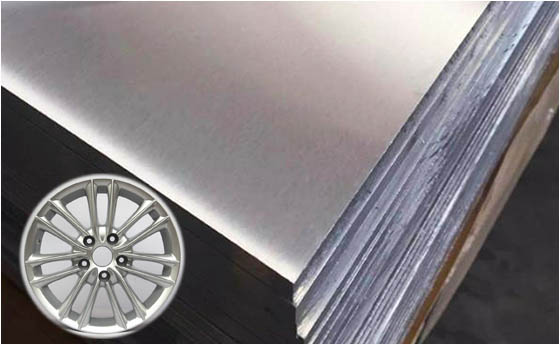- Email: sales@flait-aluminum.com
- Tel: 0086-13203837398

Aluminum alloy wheels have become a signature feature of modern automobiles, significantly enhancing not only the vehicle’s aesthetic appeal but also playing a crucial role in performance, safety, and energy efficiency. Automobile aluminum alloy wheels are the perfect crystallization of lightweight technology, material science, precision manufacturing and industrial aesthetics. Choosing a qualified aluminum alloy wheel is not only an upgrade of vehicle performance, but also a commitment to safety and quality.
Flait Aluminum focuses on the research and development and production of automotive aluminum plates, and supplies a variety of aluminum alloys for automobiles. This article provides a comprehensive analysis covering materials, manufacturing processes, performance advantages, core alloy grades, and industry trends.
Compared to traditional steel wheels, aluminum alloy wheels offer overwhelming advantages:
✅ Lightweighting: With comparable strength, the density of aluminum alloy is only about one-third that of steel. Reducing unsprung mass (wheel + tire) significantly improves:
◆Handling: Faster suspension response, more stable cornering, and more precise steering.
◆Ride Comfort: Smoother filtering of road bumps and vibrations.
◆Braking Performance: Reduced inertia leads to shorter braking distances.
◆Fuel Economy/Range: Lower rolling resistance, with range improvement particularly noticeable in new energy vehicles (NEVs).
✅ Superior Heat Dissipation: Aluminum alloy’s thermal conductivity is over three times that of steel, enabling rapid dissipation of brake heat into the air. This effectively prevents brake fade, enhancing driving safety (especially during long descents or spirited driving).
✅ High Strength and Stiffness: Through appropriate alloy selection and manufacturing processes (casting/forging), mechanical properties can meet or even exceed those of steel wheels, ensuring load-bearing capacity and impact resistance.
✅ Excellent Corrosion Resistance: The naturally formed oxide film on the surface, combined with subsequent coatings (electrophoretic deposition, spray painting), provides long-lasting protection, maintaining aesthetics and durability.
✅ Design Freedom and Aesthetics: Casting/forging processes enable complex and intricate designs, satisfying diverse aesthetic needs and elevating the vehicle’s overall grade.
✅ Precision Manufacturing and Dynamic Balance: Facilitates high-precision machining, ensuring excellent dynamic balance performance and reducing high-speed vibrations.
The mainstream manufacturing processes for aluminum alloy wheels and their characteristics:
| Process Type | Main Method | Characteristics | Application |
| Casting | Low Pressure Casting (LPC) | Molten aluminum fills the mold under low pressure, solidifying sequentially. | Economy/Mainstream OEM Standard |
| Gravity Casting | Relies on gravity for mold filling. | Low-end market or spare wheels | |
| Flow Forming | Heats and high-speed spin forms the rim section of a low-pressure cast blank. | Mid-high performance cars, upgrades | |
| Forging | Monoblock Forging | High-strength aluminum alloy billet plastically deformed under immense pressure (die forging). | Top performance cars, racing, high-end upgrades |
| Multi-piece Forging | Wheel spokes and rim forged separately and bolted together. | High-end customization, bespoke |
Aluminum alloys for wheel hubs must simultaneously meet high strength, high toughness, excellent casting/forging performance and corrosion resistance. The mainstream grades are concentrated in the 5xxx and 6xxx (forging) series:
 5xxx series aluminum alloy (Al-Mg):
5xxx series aluminum alloy (Al-Mg):Representative grades: AA5083 aluminum plate, AA5154 aluminum plate, AA5454 aluminum plate. Mainly use its excellent cold work hardening ability and corrosion resistance. But the absolute strength is usually lower than the 6xxx series T6 state, and its application in forged wheels is not as extensive as the 6xxx series.
 6xxx series aluminum alloy (Al-Mg-Si):
6xxx series aluminum alloy (Al-Mg-Si):Representative grades: AA6061 T6 aluminum alloy, AA6082 T6 aluminum alloy. This is the absolute main force of forged wheels.
Composition characteristics: Balanced Mg and Si content can form strengthening phase Mg₂Si.
Key state: T6. After forging, the peak strength is achieved through solid solution + aging treatment.
Typical properties (AA6061-T6):
🔹Tensile strength (Rm): ≥ 310 MPa
🔹Yield strength (Rp0.2): ≥ 275 MPa
🔹Elongation (A): ≥ 10-12%
Advantages: Extremely high strength/weight ratio, excellent fatigue performance, good corrosion resistance (especially T6 state), excellent machinability (forging, cutting). AA6082 aluminum plate is more commonly used in Europe, and its strength is slightly higher than 6061 aluminum plate.
 Extreme lightweight
Extreme lightweight◆ Structural optimization design: Use CAE simulation for topological optimization to remove redundant materials (such as hollow spokes) while ensuring strength.
◆ Popularization of advanced technology: Spin casting wheels replace ordinary casting in the mid-range market; the cost of forged wheels is expected to decrease (especially domestic production).
◆ Material upgrade: Research and develop high-strength casting alloys (such as improved A356, new Al-Si-Mg-Cu series); explore the application of higher-strength 7xxx series (such as 7050, 7085) for forging (stress corrosion problems need to be solved).
 Exclusive needs for new energy vehicles
Exclusive needs for new energy vehicles◆ Weight reduction and efficiency improvement: Electric vehicles are more sensitive to unsprung mass, and lightweight wheels have a significant effect on improving endurance.
◆ Aerodynamic optimization: Design low-drag wheel shapes (such as closed/semi-closed spokes) to reduce turbulence and further improve energy efficiency.
◆ Changes in load requirements: Electric vehicles are heavier, and higher requirements are placed on wheel strength/rigidity.
 Intelligence and functional integration
Intelligence and functional integration◆ Convenience of integrated installation of tire pressure monitoring sensors (TPMS).
◆ Explore hub motor integration technology (extremely high requirements for hub structural strength and heat dissipation).
 Diversified and environmentally friendly surface treatment
Diversified and environmentally friendly surface treatment◆ High-gloss polishing, high-transparency varnish, matte, brushed, two-color, multi-layer spraying, etc. meet personalized needs.
◆ Environmentally friendly water-based paint and powder coating are widely used.
Original Source:Automobile Aluminum Sheet Plate